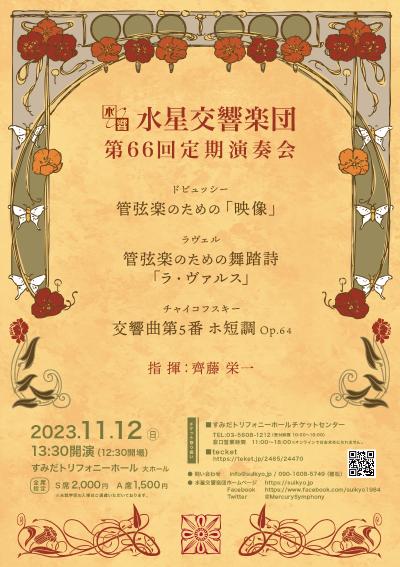The content on this website is provided by machine translation and has a risk of containing errors. Please confirm with the organizer about the detail before you go.
Mercury Symphony Orchestra
The 66th Regular Concert
2023/11/12(su.) 13:30 Starting
Sumida Triphony Hall, Main Hall (Tokyo)
Official https://suikyo.jp/
What is "composing"? To simplify it as much as possible, it is the process of giving sound form to "something" in the composer's mind. The "something" that was the source of inspiration for the three works we will discuss here is also very diverse, ranging from the ambiguous to the concrete, from the visual to the narrative.
First of all, Debussy. In his catalog of works, there are a total of four collections entitled "Images. The "Images" for orchestra, written intermittently between 1905 and 1911, consist of three separate pieces, two with Scottish and Spanish backgrounds. The two pieces with backgrounds in Scotland and Spain, in particular, seem to be the sound of Debussy's "images in his brain" reflecting the exoticism that was prevalent in France at the beginning of the 20th century.
Next was Ravel. La Valse" has the unusual subtitle "Dance Poem for Orchestra," but at the time of its conception, it was a symphonic poem titled "Viennese" inspired by the Vienna Waltz. The original plan was interrupted by World War I, and the work was written in 1920 as a new work for the Ballets Russes, commissioned by Diaghilev. It is an amusing episode that Diaghilev refused to accept it after hearing a trial performance with two pianos, saying, "This is not a ballet but a ballet 'picture'".
And one more piece related to "Waltz". Along with Berlioz's Symphonie fantastique, Tchaikovsky's Fifth Symphony is considered to be the twin perfect example of a symphony that incorporates a waltz. It is one of Tchaikovsky's masterpieces, sometimes called his "Symphony of Destiny. It is said that this piece was born out of his thoughts about "life and fate, life and death, and God (religion)" during the summer of 1887, when he was staying with a friend who was dying.
We," who translate the "work" into sound, do not necessarily ignore these episodes, but rather aim to be faithful to the specific score itself rather than being overly concerned with these episodes. What kind of "images" will come into your "head" when you hear "we" play, I think you will enjoy it on the day of the concert.
Performer
-
Eiichi Saito
Conductor
Admission and ticket purchase
-
Admission fee
All seats reserved (S seats 2,000 yen, A seats 1,500 yen)
The first 150 people to arrive will be admitted free of charge via the following website (3rd floor A seats only, no seat selection). -
How to buy
■electronic ticket teket
URL:
■Sumida Triphony Hall Ticket Center
Phone: 03-5608-1212(Office hours: 10:00-18:00)
Office hours: 11:00-18:00 *Not available for online purchase.
Contact
-
Email
-
Home page
